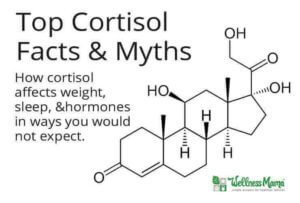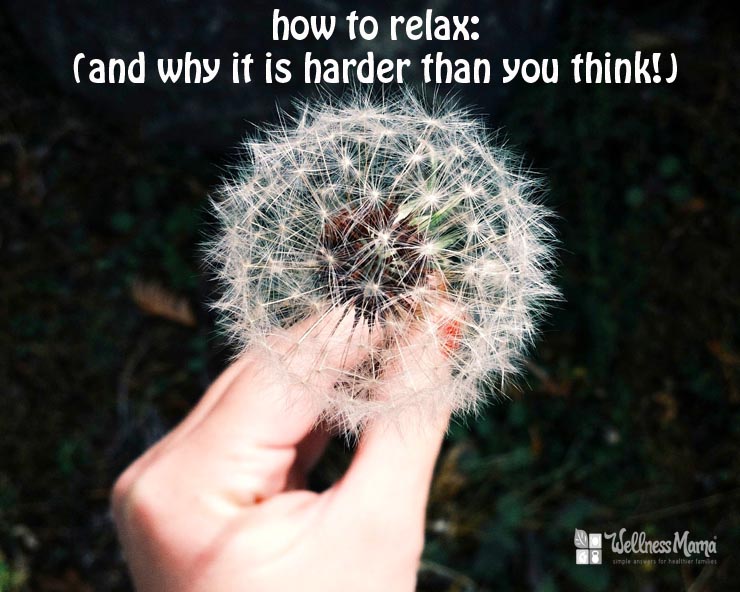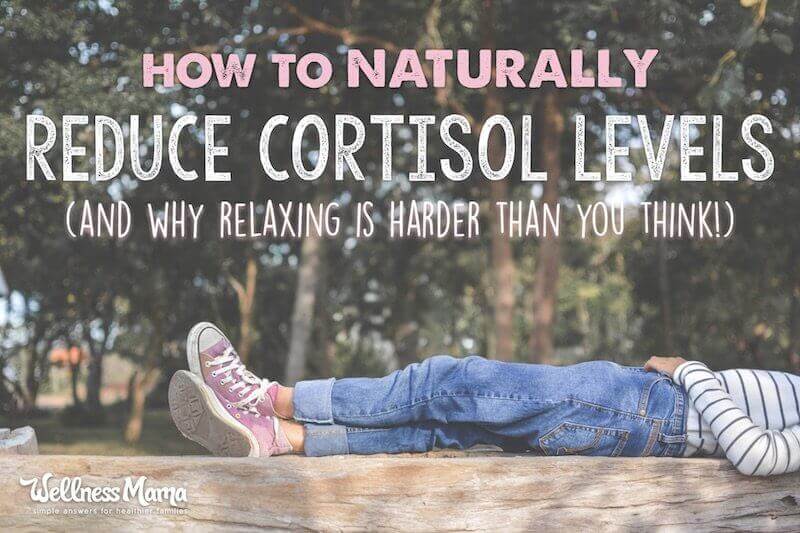Oh, relaxation, that elusive activity that is often talked about and rarely achieved in today’s world. We all know we have too much stress and need to reduce it, but the execution is so elusive! Most of us probably know that our cortisol levels may be off, but fixing this takes more that just a spa day or some deep breathing.
The good (or bad) news is that even if we wanted to “relax” and schedule time for that purpose (scheduled relaxation?) we might not be able to actually relax, at least not in the strictly physical sense. True relaxation goes much deeper than the dishes getting done and no children crying.
I learned this lesson the hard way when for years I tried to “power through” the tough newborn years. Over time, my cortisol levels became elevated at the wrong time of day and I suffered the consequences for years. Here’s what I wish I’d known…

What Is Cortisol?
Many of us now understand that cortisol has ties to stress levels, aging, and belly fat. But, what is cortisol and how is it related to your health?
Cortisol is an adrenal hormone that manages your body’s daily rhythm. Think of it as your built-in coffee pot. You wake up in the morning because your adrenals just made a fresh batch of it. You fall asleep at night because they shut it off.
Besides just being awake or asleep, you’d be amazed at how much of the body is run on a 24-hour schedule. Regulation of fat, digestion, immunity, blood sugar regulation, hunger, mental focus, and upkeep on your skin, hair, and nails all are controlled by the rhythm of cortisol.
How Modern Life Alters Cortisol Levels
Before our modern way of life, we had lots of cues that kept our cortisol rhythms in sync. The most powerful were the bright bluish light of dawn and the orange light of sunset. Feeling cold at night was another cue as was having a larger meal in the evening. Today we have many fewer cues to correct our cortisol rhythm and many new factors that throw it off. These include:
- sugars, especially fructose
- emotional stressors
- pollutants, including lead and plastic compounds
- medications
- insomnia
- shift work
- noise pollution
The Cortisol-Stress Connection
The good and the bad news is that cortisol is tied to many things besides just what we think of as mental stress. In today’s world, our bodies feel stress from all those sources in our environment and addressing them can help not just reduce the feeling of stress but improve our cortisol rhythms.
For me, this was a huge factor in regaining my health and has even helped my thyroid improve.
Research also shows poor cortisol rhythms may be contributing to some of the biggest health problems of our time. In fact, one study of British civil servants showed that bad cortisol rhythms killed more people than smoking, heart disease, diabetes, or obesity.
Never assume that sleep or stress levels are minor factors for health!
Symptoms of Cortisol Imbalance
Telltale signs that your cortisol balance may be off include:
- sluggish in the morning (even with sufficient sleep)
- tendency to want to sleep late
- headaches
- strong food cravings (especially for sugar and carbs, especially mid-morning and mid-afternoon)
- low sex drive
- weight gain around the abdomen
- acne
- depression
- anxiety
- increased energy after 6 p.m.
- trouble winding down for bed (and a second wind of energy around 11 p.m.)
Of course these probably sound familiar and could overlap with other health issues, so if you want to know for sure, see a practitioner or get lab testing to confirm.
How I Improved My Cortisol Levels
The stress of life may be unavoidable, but bad cortisol patterns are not! When I first tested (here’s what I used), my cortisol patterns were exactly opposite of where they should be. My cortisol was low in the morning when it should be high, and high at night when it should naturally drop.
Steps as simple as timing my food strategically and being intentional with light exposure made a tremendous difference for me, and now my cortisol patterns are normal, my sleep is better, and I feel much less stressed, even though I’m still doing as much as I was (or more).
Food to Improve Cortisol Patterns
The body uses cortisol to rescue us from low blood sugar. This makes carbs a tool we can use to help regulate cortisol.
My doctor recommended that I start my day with 25-35 grams of protein and finish it with 20-50 grams of high-quality carbs from natural sources. Great options include paleo-friendly sources like sweet potatoes (yams), turnips, squash, beets, and rutabagas. Having them later in the day helps not only cortisol but a whole host of weight-regulating hormones like leptin, ghrelin, and adiponectin.
On a practical level, this means that breakfast for me is protein+ veggies and dinner is protein + healthy carbs like sweet potatoes or squash. (For anyone wondering, this can also fit with Bright Lines, I just choose high protein sources for breakfast and lunch like sardines, chicken, or lamb and make sure I get the healthy carbs at night. I essentially do the lunch plan at breakfast, the dinner plan at lunch, and the breakfast plan at dinner).
And research backs up my personal experience with cycling food to improve cortisol. In a study of 42 women with weight loss resistance, diet alone was shown to correct cortisol rhythm by over 50% in 30 days. The diet in the study used carb cycling and avoided fructose and indigestible proteins like gluten and soy.
How to Use Light to Balance Cortisol
Light also had a huge impact on my cortisol levels. I was skeptical at first but after dietary changes didn’t completely fix my levels, I tried the light changes and the results were dramatic. Here’s why…
High cortisol can cause weight gain but so can low cortisol or cortisol made at the wrong times. Light is often the cause of the cortisol at the wrong times. When we are exposed to blue light (phones, computers, TV etc.) after dark, the body is getting the message it is early afternoon and then produces cortisol and reduces melatonin. This is the opposite of what we should do at night to get an optimal night of sleep.
In the same way, when we spend a lot of time indoors and don’t get any bright outdoor light exposure during the day, our body never gets a clear signal of night and day.
Simple steps like getting one half-hour of sunlight within an hour of waking can help cortisol if it is too high or too low. If this is not possible during certain seasons, a light-box that generates 10,000 lux of light can work as a good substitute.
The three steps that made the biggest difference for me are:
- Getting bright sunlight or exposure to a lightbox within an hour of waking up (great for fighting SAD as well)
- Avoiding blue light at night by wearing orange sunglasses if I was going to use electronics after dark.
- Having lamps with orange bulbs (such as salt lamps) in each room and turning those on instead of bright overhead lights after dark.
Addressing Environmental Stressors
Over time, I also addressed some of the other factors my body viewed as stress. These included environmental toxins, my sleep patterns, exercise, and my inability to say no. I found that light and food cycling were the critical factors for me, but these other changes helped me see continued improvement after I’d addressed the core problems with light and food.
Avoiding Environmental Toxins
This step goes along with the food step above, as unfortunately, our “food” supply can be a major source of unnecessary chemical exposure that the body views as stress. But we also encounter environmental stressors in the form of chemicals in toothpastes, personal care products, deodorants, medicines, and cleaning chemicals.
Our exposure to large amounts of plastic, especially plastics that have been heated in the microwave, can also cause a build-up of estrogenic compounds in the body and alter our hormones. If the body is in a state of stress, the liver and kidneys are also not functioning optimally, making toxin removal slow and ineffective.
I focused on:
- using only natural beauty and personal care products (see all of my recipes here)
- avoiding plastics and storing food in glass
- drinking enough water to make sure my body could flush out anything it removed
- using only natural cleaning products
- avoiding environmental toxins like pesticides and herbicides
- avoiding antibacterial soap that contains chemicals like triclosan
Instead, I make my own (try it… you’ll save money too!):
If you don’t have time (or want) to take the DIY route, there are now plenty of awesome companies doing the world a favor and making health-conscious products (thanks I’m sure to the moms/consumers who demand them!).
I definitely did not make the changes above overnight, so a word of encouragement: any change is a good change! Be patient… and start with food and light!
(p.s…. In hopes it will help other moms walking the same path, I share everything I learned and all of my favorite recipes and products in this 5-Step Lifestyle Detox guide, available soon!)
Making Sleep a Priority
This is one of the most important steps in stress reduction, and the one we are worst at. Historically, the body is used to sleeping when it is dark and being awake when it is light. When we stay awake long after the sun has set and don’t get enough cumulative sleep, we interrupt the body’s natural time for restoration and removal of toxins. The optimal time for regeneration during sleep is roughly between 10 p.m. and 2 a.m. Many people don’t sleep during part or all of this time, causing a backup of toxins and hormones in the body.
The body also has a delicate balance of hormones and depends on serotonin and melatonin to regulate good sleep and alertness during the day. Lack of sleep or interrupted sleep can disrupt the balance of these hormones, making you groggy during the day and restless at night. Poor sleep can also (logically) lead to fatigue, brain fog, memory troubles, and additional stress on the body.
Things like earthing and using magnesium can help improve sleep quality and reduce stress while you sleep. I’ve also found that when I do have to work at night on the computer, using blue-blocking orange sunglasses can help keep proper melatonin levels and cortisol patterns. (See recommendations at the end of this post.)
But at the end of the day, we have to learn to prioritize sleep.
Learning to Say No
Another logical step that many of us are bad at (me especially) is saying “no.” I’m not just talking about saying no in a parenting sense (though that could be good too… I recommend “No, you may not eat that candy bar/happy meal/ding dong/fill in the blank”).
Many of us have a commitment list as long as our arms, and the stress level to prove it. It is wonderful to help out whenever we can, but make sure you make yourself a priority and realistically evaluate what you can handle while keeping stress low and quality family time high. (Confession: I am really bad at this step myself!)
Adrenal-Safe Exercise
Oddly enough, exercise is a type of stress. It can be really helpful in reducing stress in the body but it serves us best when it is challenging but not overwhelming. The biggest factors determining if it is good or bad include: how stable our adrenals are and how much exercise we are already used to.
My doctor explained that the most adrenal-friendly types of exercise are light exercises like stretching and pilates. Walking and swimming would also be good options. The least adrenal-friendly activities include triathlon training or back-to-back days of high-intensity interval training.
If you have an autoimmune imbalance (like I do) and want more advice about which type of exercise is best for your body, check out this podcast.
Up the Antioxidant-Rich Foods
Antioxidants can help counteract the damage done by free radicals and stress hormones in the body. I made a conscious effort to up my antioxidant consumption from real food sources. This meant lots of antioxidant-rich fruits and vegetables, but also natural sources of vitamin C and other antioxidants.
During my food/light experiment, I also noticed I felt better when supplementing with vitamin C.
Learning to Actually “Relax”
Many people are too tired after an exhausting day to engage their minds and prefer to “relax” by watching TV or some other form of electronic distraction. There are some theories about the sleep-disturbing ability of the blue light emitted by these electronics, but whether you believe them or not, all that time spent watching TV is time that our minds are actively disengaged. Studies repeatedly show that people who actively use their minds in activities like reading, puzzles, or learning languages/new hobbies are happier and less stressed.
Consider using your valuable time for an activity that improves your mind and reduces stress.
On the flip side of this coin, most people also don’t turn their minds off enough. Let your “relax” mean “relax” and don’t relax by watching TV or doing another activity that causes activity without engaging the mind. Take time to pray or meditate and try to focus on the positive aspects of your life and the things you are grateful for.
Bottom Line: Start Balancing Cortisol Today!
All in all, relaxation is easier said than done. Heck, I just gave you my own to-do list I had to use to learn to relax! But focusing on cortisol levels is a great way to reduce the physical impact of stress hormones on the body and improve sleep.
Here’s a quick recap of the steps you can take starting today, without spending a dime:
Start your day with:
- Bright light/sunlight in the morning
- Have high protein in the morning
Finish your day with:
- Limited light in the evening (no screens and dim the lights after 7 p.m., for example)
- Healthy carbs with dinner
Tools & Supplements That Help Reduce Cortisol:
If you think you need more help in addition to the above changes, these resources helped me:
- 10,000 lux lightbox (sunlamp) – or time outside in the morning, if you can!
- Blue-light blocking glasses
- Earthing mat
- Magnesium supplement
- Magnesium oil
- Circadian Rhythm essential oil blend from Vibrant Blue Oils
Recommended Reading:
- The Complete Idiot’s Guide to Thyroid Disease
- Healing Hashimoto’s – A Savvy Patient’s Guide
- The Adrenal Reset Diet
This article was medically reviewed by Dr. Mariza Snyder, a functional practitioner. As always, this is not personal medical advice and we recommend that you talk with your doctor.
Have you ever struggled with cortisol issues such as hormone imbalance or trouble sleeping? What has helped you?





Leave a Reply